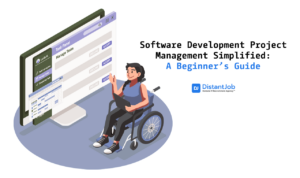At its very heart, cultural intelligence is empathy. It’s about understanding a different point of view. In a distributed team, that understanding becomes even more crucial.
Teams are often assembled with similarities in mind. Similar zeal for innovation, creativity, and ability to work independently is great.
However, ideological homogeneity only results in a stalemate.
That’s why when you let DistantJob find you remote developers from all over the world, you’re automatically upping your diversity game.
But, according to the foremost expert on the subject, Dr. David Livermore, diversity for its own sake is dangerous. When diverse individuals don’t get along, they perform worse than a homogenous group.
To make the most of its intellectual assets, your remote team needs Cultural Intelligence (CI).
How is Cultural Intelligence relevant to remote teams
Cultural intelligence goes beyond learning about other cultures. It could be differences between genders, race, religion, sexuality, even political affiliations.
With the election coming up, surely “red or blue” is a topic of conversation that can crop up in the office. Depending on the answers, would some of your team members struggle to fit in?
Learning how to navigate and leverage these differences, without causing a rift, is essential.
Studies also show creativity is higher among people who have a cultural drive, can co-relate between their and other cultures, don’t need rigid answers, and belong to diverse teams – “not only nationally and ethnically but functionally and ideologically”.
Further, a McKinsey report states that organizations with higher diversity are “35% more likely to have financial returns above their national industry median”.

Pic: Capabilities of Cultural Intelligence
How to apply the Four Cultural Quotient (CQ) Capabilities in distributed teams
According to the report (PDF), Cultural Intelligence: The Essential Intelligence for the 21st Century from the Society for Human Resource Management (SHRM), Cultural Quotient (CQ) has four capabilities.
1. CQ Drive
This is the motivational aspect of Cultural Intelligence. It asks whether someone has the motivation and drive to work with people of another culture/viewpoint.
If someone inherently abhors cultural differences, simply topping their belief system with office rules will never lead to a real collaboration.
Diversity in such a case will only create tension and hurt the team’s performance.
The three sub-dimensions of CQ Drive are:
- Intrinsic interest – it’s how much a person enjoys learning about another culture/view for its own sake. You should ensure your employees have some intrinsic cultural interest during recruitment.
- Extrinsic – refers to the tangible benefits of being culturally aware. In a distributed team, that could mean that culturally sensitive members have better opportunities.
- Self-efficacy – shows how confident a person is working in a diverse team.
CQ Drive is particularly significant in the hiring stage.
2. CQ Knowledge
CQ Knowledge refers to the cognitive part of cultural intelligence. That is, having a broad-spectrum understanding of how cultures vary and how they can affect work.
The two dimensions of CQ Knowledge are:
- Cultural-general understanding – it’s the bird’s eye take on various cultural and social norms.
- Context-specific understanding – involves knowing how a particular set of norms/values will affect a business in a particular industry. Let’s say your IT company operates in or hires from Latin America. The rest of your team should have specific knowledge of communication styles, work approaches, and thought processes that pertain to that culture.
For instance, as far as following rules go, North Americans are usually Universalists. They believe that the same rule applies to everybody. Whereas, Latin Americans are generally Particularists. They think that rules should depend on situations and is relationship-based. However, that doesn’t mean cultures can be stereotyped.
CQ Knowledge is the part of CI that gets the most attention – that employees and leaders should learn about other cultures. While that’s irrevocable, the SHRM report states that CQ Knowledge has to work in unison with the other three capabilities to raise the CQ of your organization.
3. CQ Strategy
This involves the metacognition aspect of CQ capability. Someone with high CQ Strategy can solve problems by preparing beforehand, observing during the interaction, and reacting appropriately afterward.
The three sub-dimensions of CQ Strategy are:
- Planning – being aware beforehand and taking steps to prepare for a culturally diverse situation. Like learning about the countries that your team members are from before they join.
- Awareness – being conscious about your thoughts as well as the other person’s during an intercultural interaction. Such as being aware of how they might participate in their first team meeting.
- Checking – taking notes and revising your understanding of cultural notions based on your interactions. For instance, how the new teammate participated in a meeting will give you insight into how to interact with them in the future.
CQ Strategy is the bridge between understanding cultural differences and using them to your benefit.
4. CQ Action
This is the behavioral aspect of cultural intelligence. It’s about knowing how to act based on cultural differences. And, also knowing when not to adapt to these differences.
The three sub-dimensions of CQ Action are:
- Speech acts – using specific language to reflect understanding in an intercultural context.
- Verbal actions – modifying intonation, volume, and pace to reflect changes.
- Non-verbal behaviors – using gestures, expressions, personal space to communicate action.
CQ Action is evaluating various methods of interactions and being flexible enough to try new approaches.
How to measure and increase the cultural intelligence of your remote team
Measuring CQ
CQ tests can reveal the gaps your employees have in their CI and how to address them.
Many tests measure CQ. Such as Multi-rater assessments (360 feedback), the Multicultural Personality Questionnaire (MPQ), Intercultural Development Inventory (IDI), Implicit Association Tests (IAT), Intercultural Adjustment Potential Scale (ICAPS) or the Cultural Intelligence Scale (CQS).
But you have to know what precisely you want to measure so that you can pick the appropriate test.
For instance, one of the above tests, MPQ, measures individual beliefs that are unlikely to change. Knowing what those are and how that might affect a candidate’s team interaction can make a difference to the hiring process.
Implementing CQ
CQ is highly dependent on individual team members, your work, your clients, where you operate. And a one-on-one approach is best when training employees in CI.
But there are qualities and behaviors you can encourage that will help CI flourish in your remote teams. Like:
- Always encourage open communication
- Build trust within your teams
- Encourage flexibility in work methods, problem-solving, and collaboration
- Give employees independence on how to accomplish tasks
- Celebrate a culture of difference and acceptance
- Find common grounds between teammates to help them bond
- Remove focus on being right, focus on listening to others
- Suspend judgment in all forms from your distributed teams
- Deep-dive into specific cultures and differences as it pertains to your business
- Make learning about CQ a part of the onboarding process and keep testing and updating
- Use positive reinforcement to increase CI.
Learning about another culture, being sensitive to differences, and working well with people of different ideologies happen when all parties commit. We go to great lengths to find you candidates who will do their part in crossing that bridge. Write to us to learn more.




